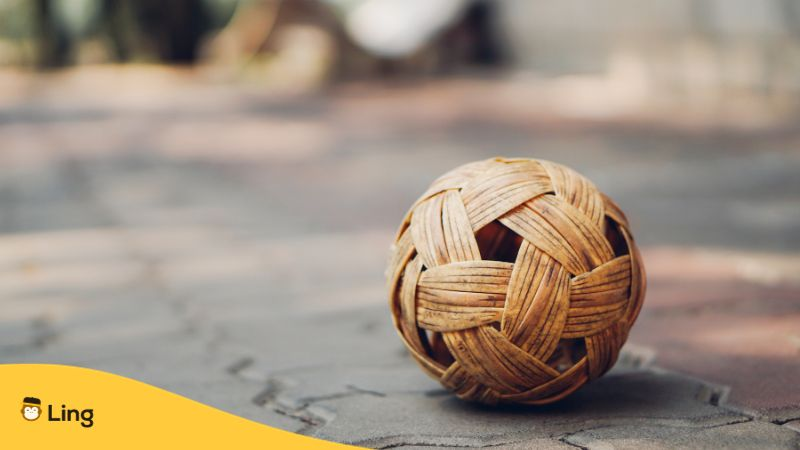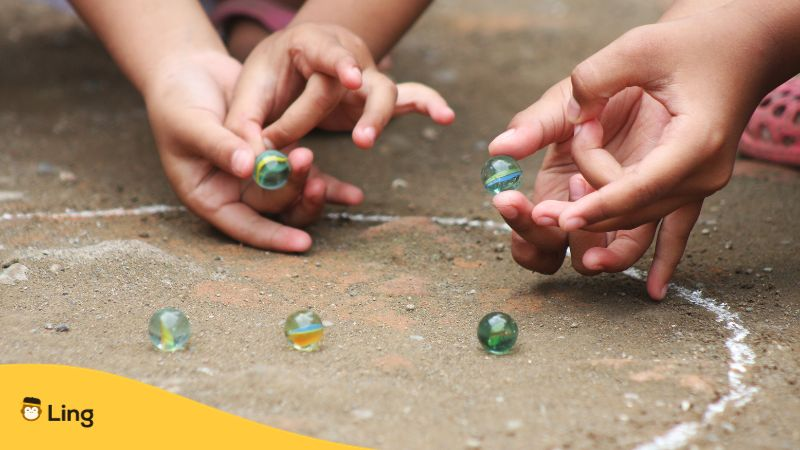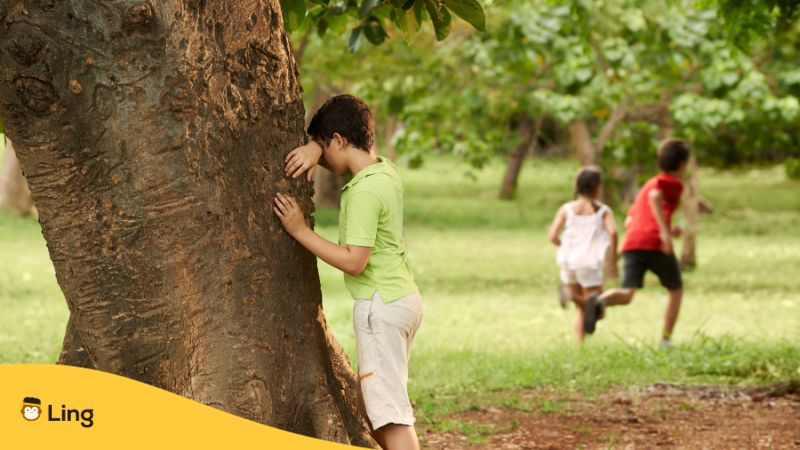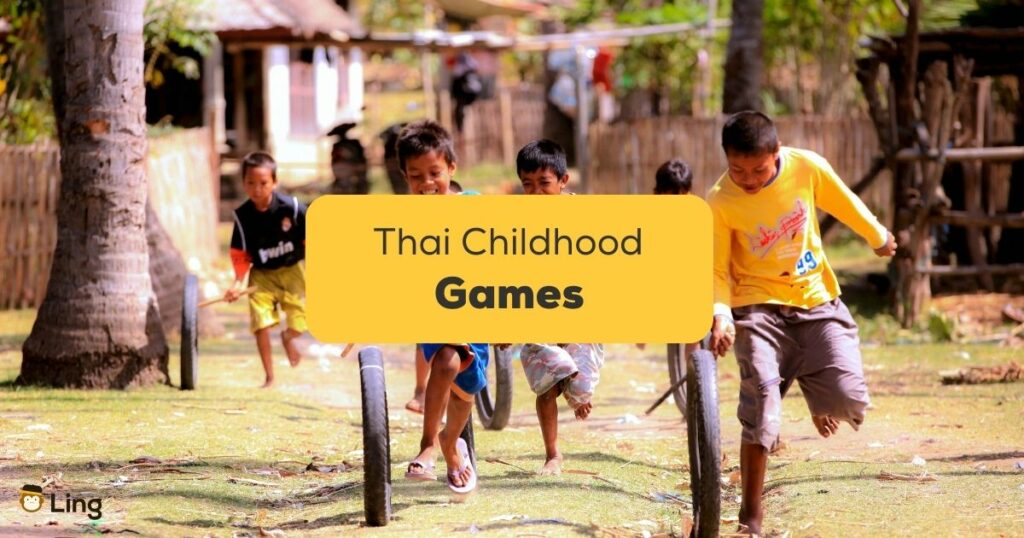From the spirited chase of “Pee Seua Krong” (Tiger King) through the streets to the intricate strategy of “Kon Toong Ma” (Hopping Ball), Thai childhood games are truly unique. Not only do they reflect the Thai culture, but also greatly show the things that make people feel happy and relaxed. Want to learn more about it? Read on below!
Childhood Games In Thai
Childhood games or “เกมในวัยเด็ก” (Kem nı wạy dĕk) in Thailand, a country from Southeast Asia, have a rich and culturally significant origin that dates back centuries. Many of these traditional games have their roots in Thai folklore, mythology, and daily life. For example, games like “Saba” and “Khee Ma” are inspired by Thai agricultural heritage, where children mimic the activities of farmers by planting rice or plowing fields in a playful manner. Other games, like “Pak Ta Luk Nok” (a variation of duck, duck, goose) and “Saba Yoo” (a form of tag), reflect the close-knit communities in Thai villages, promoting social bonding and unity among children.
The significance of these childhood games goes beyond mere entertainment or “ความบันเทิง” (Khwām bạntheing). They serve as a means of preserving and passing down Thai cultural values, traditions, and customs from one generation to the next. These games teach children important life lessons such as teamwork, respect for elders, and the value of hard work, all while fostering a sense of belonging within their communities.
Moreover, these games promote physical activity and social interaction, contributing to the overall well-being and happiness of Thai children. As a testament to their enduring importance, these traditional games continue to be cherished and played by Thai youth, ensuring that the cultural heritage of Thailand remains vibrant and celebrated.

Thai Childhood Games
Sepak Takraw
Children frequently participate in this sport informally in Thailand. Similar to volleyball, but using a rattan ball, it is played with the feet, head, knees, and chest. It is a well-liked sport in Thailand and is frequently played casually by kids. Players use their feet, heads, knees, and chest to knock the ball over a net in a similar fashion to volleyball but with a rattan ball instead.
Kai Pla Kao
This type of game of tag is common in Thailand. As “it,” one player tries to tag the other players. When tagged, a player must remain motionless until an untagged player creeps between their legs.
Nak Phaen Din
This is the hopscotch game in Thai. Children commonly use chalk to construct a grid on the ground, and then take turns hopping among the squares as they attempt various chores or challenges.
Ongkarn Sen Teng
Children build an arch with their arms in this Thai version of “London Bridge is Falling Down,” and one child passes underneath as the others sing. The child underneath must make a decision regarding who will join them when the song is finished, and then the arms will descend.
Took Yan Nguern
Children gather in a circle and play a Thai version of “Duck, Duck, Goose” in which one child walks around the outside, tapping people on the head while yelling “took” (touch). The tapped kid must chase the first child around the circle to tag them when they say “yan nguern” (silver hand).

Koh Kaeo
In Thailand, marbles are known as “Koh Kaeo.” Kids take turns using bigger marbles to try to knock marbles out of a circle; whomever removes the most opponent’s marbles from the circle wins.
Tong Moo Ban
In this game, a giant circle is drawn on the ground, and the center is filled with a small object. Children take turns trying to knock the object out of the circle by flicking their “tong” or flip-flops at it.
Luk Kreung
A child delivers directions, such as “Luk kreung bow” (touch your knee), and the other children must only comply if the command begins with “Luk kreung.” Basically, this is a Thai variation of the game “Simon says.”
Tua Kan Tok
This is traditionally played while children are seated in a circle, with one child wearing blindfolds. The other children move their hands to avoid being touched as the blindfolded child attempts to touch another child’s hand with a stick (often a rolled-up newspaper).
Tin Thang Taek
A child counts while keeping their eyes closed while the others hide in this Thai adaptation of the popular game “Hide and Seek.” They then check to locate and identify the hid participants.

Words Related To Childhood Games
Ready to level up your language-learning journey in the Thai language? Learning these words not only boosts your Thai vocabulary but also wraps you in the warm nostalgia of Thai youth.
| English | Thai | Pronunciation |
|---|---|---|
| Child | เด็ก | Dĕk |
| Fun | สนุก | S̄nuk |
| Games | เกม | Kem |
| Kids | เด็กๆ | Dĕk« |
| Children’s games | เกมสำหรับเด็ก | Kem s̄ảh̄rạb dĕk |
| Two teams | สองทีม | S̄xng thīm |
| Kite flying | ว่าวกำลังบิน | Ẁāw kảlạng bin |
| Long boat racing | แข่งเรือยาว | K̄hæ̀ng reụ̄x yāw |
| Winning team | ทีมที่ชนะ | Thīm thī̀ chna |
| Traditional | แบบดั้งเดิม | Bæb dậngdeim |
| Playful | ขี้เล่น | K̄hī̂ lèn |
| Community | ชุมชน | Chumchn |
| Unity | ความสามัคคี | Khwām s̄āmạkhkhī |
| Teamwork | การทำงานเป็นทีม | Kār thảngān pĕn thīm |
| Happiness | ความสุข | Khwām s̄uk̄h |
| Cultural heritage | มรดกทางวัฒนธรรม | Mrdk thāng wạtʹhnṭhrrm |
| Social interaction | ปฏิสัมพันธ์ทางสังคม | Pt̩is̄ạmphạnṭh̒ thāng s̄ạngkhm |
| Bonding | พันธะ | Phạnṭha |
Learn Thai With Ling!
Did reading this post transport you to a world of nostalgia and ignite a burning curiosity to delve deeper into the enchanting realm of the Thai language? Well, buckle up, because we’ve got an exciting recommendation for you!
If you’ve ever dreamt of mastering the melodious tones of Thai or simply want to take your language skills to the next level, look no further than the Ling app! With Ling, you won’t just learn Thai; you’ll embark on an adventure filled with comprehensive lessons that are as engaging as they are informative. But that’s not all! Get ready to ditch the dull textbooks because Ling offers you interactive exercises that’ll make learning Thai feel like a game.
So why wait? Available for download on both the Google Play Store and the App Store, Ling is your ultimate passport to Thai language immersion and fun learning. Give it a try now!




































































